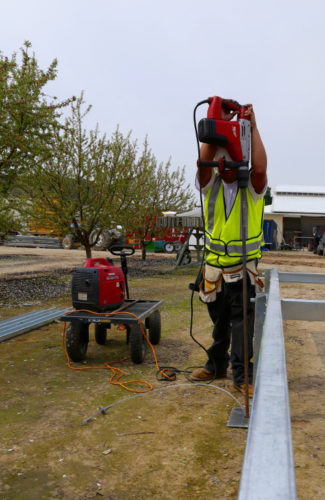It seems as though the internet of things (IoT) movement is everywhere. It’s in your fridge, texting your smartphone when you’re out of milk. It’s in your suitcase, allowing you to track its location in case it’s lost.
The solar industry is no exception. Wi-Fi-enabled inverters allow remote updates so contractors don’t have to visit a site to perform upgrades. Smartphone apps show consumers how their solar is performing or if their EV is charged.
These are some of the top product characteristics we found this year in the solar industry. We also found many innovations that reduce project soft costs, such as adhesive modules that eliminate roof penetrations, microinverters that convert power from more than one module and carports that quickly assemble on the ground. Contractors can do more projects in less time with less effort.
What follows are the SPW editors’ picks for top solar product characteristics we saw at various tradeshow and events throughout 2017. To see a full grouping of the Top Products of 2017, please view our main page here.
Monitoring software gets more granular and user-friendly
As seen in PowerTrack by AlsoEnergy
 Pinpointing module faults quickly and accurately is crucial to getting the best output from a solar array. Testing performance of string inverters is normal procedure during commissioning of a project, but testing can often be required after commissioning too. In the past, that’s meant onsite inspections that take time and money.
Pinpointing module faults quickly and accurately is crucial to getting the best output from a solar array. Testing performance of string inverters is normal procedure during commissioning of a project, but testing can often be required after commissioning too. In the past, that’s meant onsite inspections that take time and money.
A partnership between AlsoEnergy and Huawai has solved this problem. AlsoEnergy’s PowerTrack software platform incorporates Huawai’s Smart I-V Curve Diagnosis feature on its string inverters that allows for remote testing. Each inverter can execute an I-V curve scan that’s exported to an analytics engine.
O&M providers can launch and view the testing results directly on the PowerTrack interface, then download them into stakeholder reports. Partnerships between inverter manufacturers and monitoring companies mean more accurate reporting tailored to specific products, and less lost production in the long run.
Advanced, two-panel microinverters cement spot in future, high-output projects
As seen in the APsystems YC600

Demands for smart, grid-interactive inverters that support California’s Rule 21 and today’s high-output panels set the bar high for string inverters. But a microinverter that encompasses all of these capabilities is truly impressive.
The YC600 from APsystems was designed to accommodate high-output PV panels and meet the latest grid compliance standards, including UL 1741 SA requirements for Rule 21. The YC600 offers 300-VA peak power output per channel to accommodate 60- and 72-cell panels. Each unit serves two modules, which reduces the number of components and installation needed. Still, it maintains independent MPPT with a wide range to capture as much irradiance as possible even in low-light conditions. It also has a durable, NEMA 6/IP67, powder-coated aluminum enclosure, while other models use plastic casings. On top of all that, an integrated ZigBee antenna offers wireless communication for fast, accurate data monitoring.
Microinverters with advanced functions on par with or beyond the capabilities of string inverters will enable them to continue to be a viable option for projects.
Hierarchical alarm organization cuts back on nuisance alarms
As seen in Draker V7 software

Monitoring software lets O&M providers know when problems are afoot. But O&M providers can end up spending lots of money visiting sites if alarms are triggered by unnecessary factors.
Draker’s V7 software makes it easier to decide which warning flags warrant truck rolls. When an alarm goes off, users can quickly drill down to view the alarm by component and severity to decide if action is needed. And users can cut back on nuisance alarms by specifying what conditions must be met for the alarm to go off in the first place. “In other words, this alarm doesn’t run outside of the production day or if there’s really low irradiance,” said Alicia Fisk, Draker’s software success manager.
If users are getting nuisance alarms from something like morning shading, they can fine tune the system to exclude some of the nuisance alarms and get good, actionable information, not noise.
Alarms are important, but monitoring software that can give more information beyond a warning flag is crucial to saving money on O&M.
Customizable proposals help contractors woo any customer
As seen in Energy Toolbase

Solar proposals are never one size fits all. Software companies understand this and now offer a multitude of templates contractors can choose to please any customer.
One such example is Energy Toolbase’s proposal and design software. The company calls its template builder “PowerPoint for solar proposals” because users can insert and format objects, images and content to create the best possible proposal for customers in the residential, commercial and emerging battery storage market.
The residential version can focus on company brand, project portfolio, rebates and incentives to show homeowners their potential energy savings in a visually pleasing way. Commercial proposal templates are longer with more numbers and statistics—the software can simulate the reduction of demand charges and show the long-form breakout of cash flow. And an energy storage proposal can display the benefits of storage for a given system along with the various value streams. Laying out the facts in the way that best suits each individual customer can help contractors sell solar in an honest, straightforward way.
Communication-compliant inverter eliminates need for rapid-shutdown box
As seen in the Fronius Symo Advanced string inverter
T he SunSpec Alliance recently released a rapid-shutdown specification that serves as a communication protocol to define how solar modules, inverters and other control systems interact to power down in accordance with new NEC requirements, effective January 2019. Microinverters inherently meet rapid-shutdown codes because they attach to each panel, and module manufacturers implement the protocol within the junction box of each panel. Most string inverter manufacturers incorporate the protocol in a separate master control device, often referred to as a rapid-shutdown “box.”
he SunSpec Alliance recently released a rapid-shutdown specification that serves as a communication protocol to define how solar modules, inverters and other control systems interact to power down in accordance with new NEC requirements, effective January 2019. Microinverters inherently meet rapid-shutdown codes because they attach to each panel, and module manufacturers implement the protocol within the junction box of each panel. Most string inverter manufacturers incorporate the protocol in a separate master control device, often referred to as a rapid-shutdown “box.”
However, Fronius’s new Symo Advanced string inverter actually integrates communications compliant with the SunSpec protocol directly inside the inverter, so no extra box is needed. Communications with modules and other roof components are carried over system power lines, eliminating additional wiring needed with traditional shutdown boxes. This helps reduce equipment and installation costs. Fronius is also offering its second-generation rapid-shutdown box to use with existing inverter models. The new box has a sleek design to fit underneath the panel and replace a standard junction box.
Integrating communications and limiting the number of system components and installation work can help reduce soft costs, while improving safety and compliance with standards.
Adhesive modules eliminate need for roof penetrations, racking
As seen in Lumeta Lynx modules

Adhesive solar panels aren’t new, but non-thin-film adhesive modules are something to notice. Frameless, glassless monocrystalline 300-W modules with a sticky backside eliminate the need for bulky racking, grounding and roof penetrations, and they can compete with their glassed cousins in production and efficiency.
Lumeta released its LPP line of adhesive modules earlier this year for asphalt shingle and tile roofs, but their ~180-W output left much to be desired. Now the company has announced its Lynx line of modules ready for Q1 2018 shipment—Lumeta Lynx 60 (60 cells, 300 W, 18.1% efficiency) and Lumeta Lynx 72 (72 cells, 360 W, 18.3% efficiency).
Dupont plastic-based front sheets replace the glass, and a tapered-edge seal removes the need for grounding and lessens soiling. Time-proven butyl roofing adhesive secures the module to the roof and guarantees its adhesion for the system’s lifetime, but it is removable if required. No penetrations, no mounting equipment, wind tunnel tested, aesthetically marketable—Lumeta’s adhesive modules have a lot of benefits and have been tested to NREL’s Qualification Plus standard. Adhesive modules cut installation time significantly—and just think of the fewer BOS products needed.
Earth anchors offer new concrete-free ground-mount solution
As seen in Nuance Energy’s Osprey PowerPlatform
 Concrete is common on traditional ground-mount solar arrays, either used to set steel piles or in ballast blocks. To avoid the goopy stuff, one could turn to ground screws, but their need for heavy equipment to install can be equally as expensive and time-consuming. Switching to earth anchors allows ground-mount projects to be installed quickly, even with unexperienced crews, without concrete and using only hand-tools.
Concrete is common on traditional ground-mount solar arrays, either used to set steel piles or in ballast blocks. To avoid the goopy stuff, one could turn to ground screws, but their need for heavy equipment to install can be equally as expensive and time-consuming. Switching to earth anchors allows ground-mount projects to be installed quickly, even with unexperienced crews, without concrete and using only hand-tools.
Earth anchors have been used in many other applications, and when used in solar foundations, they don’t require detailed geotechnical reports, extensive engineering effort or costly construction techniques. It’s been estimated that using Nuance Energy’s Osprey PowerPlatform—a modular racking system that uses earth anchors—on a 2-MW project can save $130,000 due to lower field labor costs, no pile driving and no geotechnical reports.
Earth anchors work in a variety of soils, even capped landfills. The anchor and attached cable are driven into the ground using a hand-held drive rod. As the rod is removed, uplift force is applied to the cable and this “inverted cone” of soil above the anchor provides incredibly strong holding power. Installation is faster, easier and cheaper than other foundation options and could be a real game-changer for ground-mount installations big and small.
Ground assembly saves 50% of labor costs on solar carport installs
As seen in Quest Renewables‘ QuadPod

Solar carports are pretty straight forward. Steel posts are embedded in concrete, long support spans bolt to the posts and panels slide into place by installers on scissor lifts. A significant portion of assembly is done at a height, and installers go up and down to get more material.
Quest Renewables’ QuadPod flips that thinking upside down. The large majority of assembly is done on the ground and the final design is lifted by one crane onto posts. No scissor-lifts to position panels since tables come together at ground-level. People work faster on the ground, especially when not moving around in fall arrest gear on a small platform full of solar panels.
Quest Renewables estimates that assembling the bulk of the system on the ground saves 50% of typical carport labor costs. And while a crane is more expensive than a scissor lift, one crane might only cost about 10% of the amount of labor, so major savings are seen across the board.
Waterproof components help protect all solar aspects on a roof
As seen in Quick Mount PV’s QBox junction box
 When drilling holes into a roof, one should ensure a waterproof seal every time, no matter what the holes were drilled for. The industry has made great strides to properly seal holes for mounting systems. Shouldn’t the same care be paid to other BOS equipment?
When drilling holes into a roof, one should ensure a waterproof seal every time, no matter what the holes were drilled for. The industry has made great strides to properly seal holes for mounting systems. Shouldn’t the same care be paid to other BOS equipment?
Quick Mount PV took customer feedback seriously and released its QBox junction box a few months ago. More of a waterproof and watertight box to combine wires into one conduit to the attic, the QBox has a 12-in. by 12-in. aluminum flashing with Quick Mount PV’s patented Elevated Water Seal Technology. The box can install anywhere on a roof (except over a rafter, because then conduit can’t pass through) and is made of non-conductive material, which eliminates the need to ground.
The QBox secures to the roof without a pilot hole for fast installation, and a drill starter around the outside of the enclosure ensures an ideal hole location for the conduit attachment. The box comes with the required flashing, fasteners, fittings and waterproof wire nuts to transition or combine conductor strings. The watertight guarantee with all pieces and parts ensures every solar accessory has a leak-proof home on the roof.
Inverter-integrated EV charger future-proofs solar installation
As seen in SolarEdge HD-Wave inverter with EV charger

Consumer interest in solar often coincides with interest in electric vehicles. With an EV comes more electrical load, so using solar and grid energy to charge an EV can make good economic sense. However, with traditional inverters, if a homeowner decides to purchase an EV later, adding an EV charger requires separate wiring and an upgrade to the main AC panel, which can be time consuming and costly.
SolarEdge has developed an inverter-integrated EV charger that reduces the hassle of installing a separate EV charger and PV inverter. Integrating the EV charger into the inverter eliminates the need for extra wiring and conduit. Also, no additional circuit breaker is needed, which saves space and eliminates any need for an upgrade to the main distribution panel. SolarEdge also provides monitoring that enables consumers to track solar, EV and grid consumption; smartly schedule charging around time of use rates and view charging duration, all through their smart phones.
An inverter-integrated EV charger can be a good choice for consumers wanting an EV along with their solar, or if they’re looking to add one in the future. When the consumer is ready to add an EV, the upgrade can be rapidly completed using an accessory pack with minimal installation.





Tell Us What You Think!